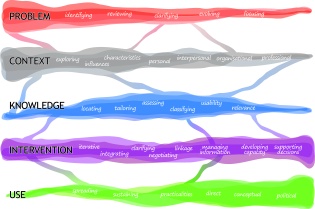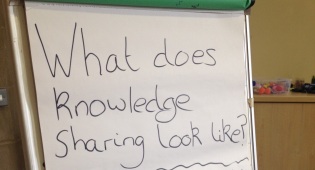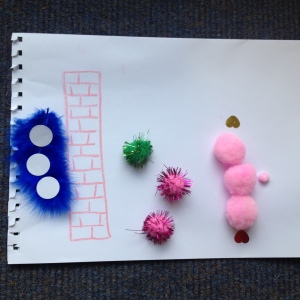Last month I wrote about using creative approaches to analyse qualitative data. I also mentioned that I was going to have a go at using a creative analysis method in my project about how health and social care staff share knowledge. Unsurprisingly, that experience has left me with a lot to think about, some of which I thought it might be good to share…
For those who know me and my work, it will come as no surprise to learn that the thing I was  most interested in was what my data had to say about the process of knowledge sharing. ‘How’ is always my go-to question, and I’m fascinated by how knowledge moves and is created between people. Although it’s now fairly well accepted that knowledge mobilisation is a complex, fluid process (and not linear, despite what many early models would have had us believe) what that actually looks like in different settings is fairly elusive. There have been some attempts to show what it might look like (including my own diagram), but work in this area has been fairly slow.
most interested in was what my data had to say about the process of knowledge sharing. ‘How’ is always my go-to question, and I’m fascinated by how knowledge moves and is created between people. Although it’s now fairly well accepted that knowledge mobilisation is a complex, fluid process (and not linear, despite what many early models would have had us believe) what that actually looks like in different settings is fairly elusive. There have been some attempts to show what it might look like (including my own diagram), but work in this area has been fairly slow.
What we have seen a lot of over the years are studies which characterise the barriers to mobilising knowledge. This leaves me frustrated because it seems to encourage people to think of knowledge mobilisation as the prize for systematically removing barriers and/or implementing standardised interventions to counteract them.
Until now I’d always been frustrated at this situation, and couldn’t quite understand why so much work had been done along those lines. But my analysis workshop forced me to be a bit more reflective. I gave my participants (a mixture of health and social care practitioners, lay rese archers and professional researchers) copies of fieldnotes and focus group transcripts and asked them to create images to show what knowledge sharing looks like. Because I always think about knowledge sharing as a moving and living process (which is why I like the term ‘mobilisation’), I expected them to create images which reflected that. But what I found was that many of the images and people’s descriptions of them focused instead on the barriers to knowledge sharing – one person’s image of a brick wall seemed to sum this up nicely.
archers and professional researchers) copies of fieldnotes and focus group transcripts and asked them to create images to show what knowledge sharing looks like. Because I always think about knowledge sharing as a moving and living process (which is why I like the term ‘mobilisation’), I expected them to create images which reflected that. But what I found was that many of the images and people’s descriptions of them focused instead on the barriers to knowledge sharing – one person’s image of a brick wall seemed to sum this up nicely.
My immediate reaction was that I must have failed to capture any sense of how knowledge is shared in my observational notes (i.e. there was a problem with my data). My second reaction was to wonder whether people weren’t able to depict a living process in a single image (i.e. there was a problem with the creative approach). But then I began to wonder whether my participants were just following a natural thought process which automatically pulls us towards determining why something can’t/isn’t happening. And then it led me to wonder whether our preoccupation with describing and categorising barriers is actually part of our genetic makeup because it enables us to deal with the complex world in which we live, rather than being overwhelmed by it.
I’m sure that there are many others out there who have done much more thinking around this than I have, and probably have a very different perspective on the issue. It would be great to hear from you in the comments section below. I’d particularly welcome any thoughts on researching KM as a living process, rather than a series of barriers!

Have you looked at Appreciative Enquiry? Makes you focus on positives – might be worth considering (some of the principles anyway)
LikeLike
You’re not the first to suggest – thanks Ruth!
LikeLike
I wonder if it is less that we are hard wired to think of problems and more “taught” that we start with the problem. Often in essay writing we are told to craft a problem statement. In grant applications we are asked to provide a pathway to impact which many of us construe as “how to have an impact on a problem”. And I cringe at how often our humanists ask their students and each other to “problematize” (cringe) something.
While I am less concerned about a problem perspective I am more concerned about a deficit perspective. If we are to address a problem (should we chose that perspective) then we cannot come at the problem from a perspective of deficits. We need to consider our assets, our allies and our enabling factors more than our deficits, our competitors and the barriers we face.
LikeLiked by 1 person
Great point, David. In my own model the ‘problem’ features large, but I often find that people shy away from thinking hard about that problem and what that looks like (and is underpinned by). In the health service here some people have talked about ‘solution-itis’ – the tendency to throw yourself into developing solutions without really thinking what you are trying to solve. I think that we all suffer from that tendency sometimes…
LikeLike
Pingback: The power of stories | KMb Researcher
Pingback: Learning lessons about knowledge sharing | KMb Researcher